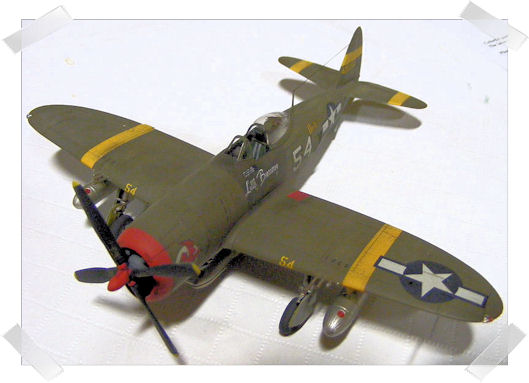|

Norma
P-47D-30-RA 57th Fighter
Group, 65th Fighter Squadron, Mediterranean
Theatre
Should you see a WWII fighter with yellow
ID stripes and/or numbers (not letters) on the fuselage,
it's a pretty safe bet that it's an aircraft of the MTO.
Famous examples are the airplanes of the 332nd
FG (aka the Tuskegee airmen) and another P-47 of the 57th,
the Hun Hunter #40.
Norma was, of course, the P-47 now
replicated at the New England Air Museum. They chose a
plane from the 57th because the group trained
at the Windsor Locks Army Air Base, which was renamed
Bradley Field after a pilot of the 57th was
killed in a training accident.
"Norma" was the name of a nurse that Lt
Brad Muhl (pronounced Mull) added to aircraft #54 to
impress a nurse he met at a dance in Italy. She took
that as a sign that he was serious about her and they
married in-theatre. A 1996 feature in the Hartford
Courant reported that their marriage was in its 52nd
year.
Norma has been kitted by Hasegawa in both
48th and 72nd scales. Their decal
sheets were the only markings available when I started
this project in 2005, but I chose to use the Tamiya kit
instead of the vintage Hasegawa plastic. My build was
over 80% finished (including decals) and on schedule for
display at our NEAM show when my retina detached for the
first time in October 2005 and the model got put aside
for a couple of years.
Hasegawa's instructions called for
painting the topside of the airplane overall OD and
their decal sheet included only the Norma name. I could
see in B&W pictures on the web that the coloring was not
uniform and that there were additional names (Helen and
Little Bunny) on the plane. This is not proof that the
subject never looked differently, but the evidence was
strong that Hasegawa's information was incomplete. I
felt I was compromising, but proceeded as they
instructed. Then, during my downtime, Eagle Cals
created a decal sheet in all scales for Norma (plus two
other P-47's).
One of the things modelers hate most is
new information after we've passed a point of
commitment. Eagle Cals not only had the missing names,
their directions also had color versions of the photos
that I had previously seen. They also explained that
the aircraft had been reacquired from the Brazilian Air
Force and that the color variations resulted from
painting over Brazilian markings. After considering the
best way to add the additional color, I made paper masks
using low tack "Post-it" glue. I mixed acrylic paint
(so that I might be able to wash it off with water if I
had a disaster) and sprayed at very low pressure. The
result was good enough for me. There were probably more
areas of over painting on the real plane, but I've
completed all that I'm sure about and don't want any
more new information. A wash of very light tan was used
to unify and tone down the upper surface colors.
Finally, I tried to break up the monotones and add a few
stains using Tamiya "Weathering Masters" which are like
little make-up packs.
Although Muhl mostly referred to
destroying ground targets, I did not know what weapons
he used. So I outfitted the model with drop tanks (more
typical of an air combat mission) as the picture seems
to show. I would have preferred to change the center
metal tank to a another paper tank but not at the cost
of another $20 kit. Although Tamiya's directions show
some typical loads without a center tank, they do not
point out that you must make that decision early in the
build since the kit is molded with an open slot that
would need to be filled in before painting.
The Tamiya kit is a gem. The only
problem area was the fit of the windscreen (which I fit
after painting). Due to the molding process, the two
short blast tubes (per wing) are molded with a recess
while the two longer tubes are molded solid. I replaced
the problem pairs with Cinemeca tubing that I purchased
at Craftec. I'll also note that Tamiya includes two
styles of exterior rear view mirror, designed to be
butt-jointed via an attachment point that's literally
the diameter of a pin, then to forever reside in a very
vulnerable place on the model. Fortunately for me, none
of the pictures show Norma with a rear view mirror.
Tough luck for the carpet monster.
Resources:
-
American Fighters Over Europe;
FineScale Modeler Books, 2006
-
Bradley Field, the First 25 Years;
Thomas C. Palshaw, 1998
-
Flying High with Norma; Lary Bloom,
Hartford Courant, 1996
For additional insights into the air war
and daily life in the MTO, I recommend "The Wild Blue"
by Stephen Ambrose. And, of course, the greatest novel
ever written (imho) "Catch 22" by Joseph Heller.
|